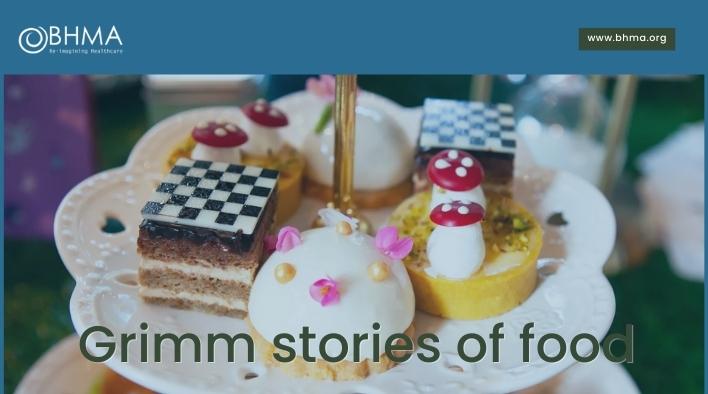Grimm stories of food
William House, Retired GP; Chair of the BHMA
Published in JHH13.2 – Nutrition and Lifestyle
[bctt tweet=”Fairy tales represent the archetypes in their simplest, barest, and most concise form… The fact that we have now relegated them to children shows a typical attitude – I could even call it a definition of our civilisation – namely, that archetypal material is looked upon as infantile.’” username=”BritishHolistic”]
When you study fairy tales you can study the anatomy of man.
Carl Jung
All animals must come to terms with the search for food. Nature has it that this search is a key driver for the cycle of life. But humans, being complex creatures, make much more of food than its survival value, though of course survival is at stake. So little wonder that folk stories often feature food. The Brothers Grimm, the celebrated collectors of folk tales, knew hunger. Though born into a comfortable background, poverty struck when their father died from pneumonia in 1796. Jacob was 11 and Wilhelm 10. After their mother died in 1808 they cared for their three younger siblings, depriving themselves of food for the children’s sake. Their one solid meal of the day was three portions shared among the five of them.
The brothers were already collecting folk tales by this time and unsurprisingly very many of them include hunger as motif, often combined with violence. In the very well[1]known Hansel and Gretel, the woodcutter’s family are starving and their stepmother persuades their father to cast out the children into the forest. As we know, the children are lured into the Gingerbread Cottage where the wicked witch plots to fatten them up and cook them for dinner. Of course, they manage to escape, the witch ends up in her own oven, the children bring back jewels from her cottage and when they find their way home (various birds help them) they discover that the wicked stepmother has died. In true fairy tale style, the ‘good’ wins out!
Another common motif in the Grimm collection is the everlasting food supply. For instance, this features in The Raven, The Magic Porridge Pot, The Magic Table and One Eye, Two Eyes and Three Eyes. The last of these is about three sisters, one with just one eye in the middle of her forehead, another with two eyes as normal, and the third with an extra eye in the middle. One-eye and Three[1]eyes torment their two-eyed sister, with old clothes, little food and work in the fields tending the goat named Bleat. One day when she is sitting weeping beside the goat, a wise woman appears and gives her magic words to say, ‘Bleat, my little goat, Bleat/Cover the table with something to eat’, and a table appears with delicious food. Later a similar little rhyme causes the table to disappear. When the two sisters and mother discover this, the mother kills the goat with a kitchen knife. With a little more help from the wise woman, and more magic, Two-eyes gets to marry a handsome young knight, and later rescues her sisters who had become beggars.
All the fairy tales collected by the Brothers Grimm are at least many centuries old, existing in differing versions all over the world. They spread and survive because they still entertain, and they transcend culture. In fact, fairy tales mirror the most basic psychological structures of man. With food as one of the fairytale motifs we reach deeply into the human condition, and not all of it is pretty. The recurring motif of hunger, for instance, reflects its ubiquity and persistence. Hunger has many causes but occurs particularly in regions of great income inequality. Both of the tales mentioned above demonstrate this. Today, 1.7 million children are living in severe poverty in the UK, and across the world, the presence of street children remains a tragic problem, especially in Latin America.
At the opposite extreme, unlimited access to food may help in the moment but is more likely to trigger jealousy and violence than the traditional happy outcome. The second story above is a good example, and is mirrored in our modern epidemic of obesity and consequent diabetes in the developed world’s overabundance of industrialised food. The importance of this is not so much to be reminded how bad things can be, but to promote fairy tales as an engaging way of teaching us about our shared nature.
The deeper metaphorical and symbolic meanings in fairy tales resonate with us whether or not we understand them consciously. Bettelheim (1991) sees Hansel and Gretel’s journey as a coming-of-age experience – escaping from childhood, experiencing the (often brutal) world, and ultimately forming adult relationships which can bring happiness. A similar journey is taken by Two-eyes. In general terms Bettelheim sees the fairy tale as externalising in symbolic form internal psychic processes. In terms of archetypes, the stock characters such as the wicked stepmother and the fairy godmother represent opposite poles of the mother image within all of us. From Marie-Louise von Franz (1991):
References
- Bettelheim B (1991) The uses of enchantment: the meaning and importance of fairy tales. London: Penguin. Von Franz M (1991) Shadow and evil in fairy tales. Boulder, Co: Shambhala.







